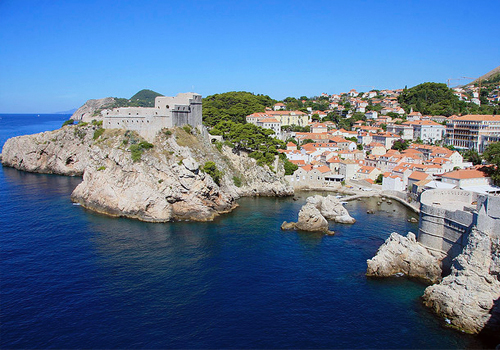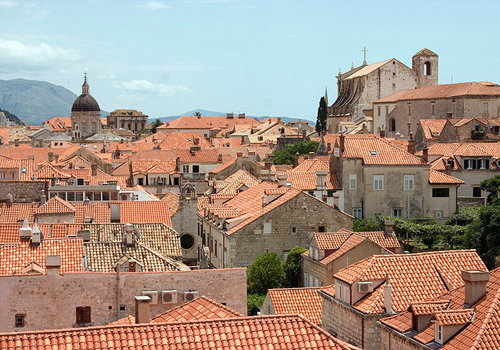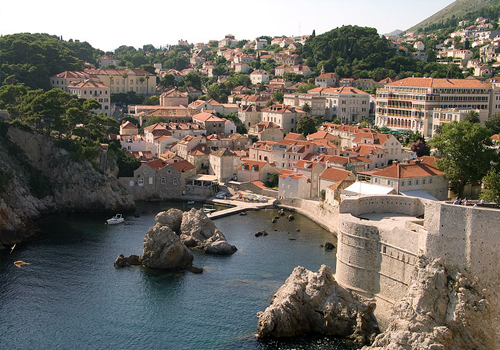Dubrovnik Travel Guide
Mljet Island
Address: Dubrovnik
Covered by forests, vineyards and small villages, Mljet Island is most famous for its national park, occupying the western half of the island. The main attractions in the national park are the two salt water lakes, Veliko Jezero (Great Lake) and Malo Jezero (Small Lake), and the 12th-century Benedictine monastery situated on an island on Veliko Jezero. The lakes are popular for swimming and the beauty of this unspoilt oasis attracts nature lovers and those in search of peace and tranquility.<br /><br /> Mljet is said to be Croatia's greenest island; in Greek mythology, it is the island that captivates the legendary hero Odysseus for seven years. Mljet is popular with couple's because the lack of crowds and the pristine natural beauty make it a romantic and private getaway. It is a great destination for those who enjoy outdoor activities like hiking, swimming, mountain biking, hunting, fishing and kayaking. There are many different kinds of accommodation available and a variety of great places to eat. This island could easily occupy nature lovers for a whole holiday.<br /><br />
Franciscan Monastery
Address: Placa 2 Dubrovnik
The original Franciscan monastery in Dubrovnik was built in the 13th century in the Pile area, but when war broke out in the 14th century the monks were forced to relocate to gain the protection of Dubrovnik's formidable defensive walls. Parts of the current monastery, and most of the church, have had to be rebuilt over the centuries due to damage, but parts of the complex date back to 1317. This Franciscan church and monastery, still enclosed in the walls of medieval Dubrovnik, boasts one of the most beautiful Romanesque cloisters in Dalmatia. Within the monastery complex there is also a working pharmacy, which has been in business since 1317, and is thought to be the third oldest pharmacy in the world. A museum houses relics from the original medieval pharmacy such as medical books, instruments and weight scales, as well as some gilded church relics. The massive monastery library - one of the richest in Croatia - is renowned globally by historians for its inventory: it contains some 30,000 volumes with 1,500 handwritten documents. The monastery is a great refuge after sightseeing in the heat and crowds of the city; it is cool and quiet and also has some gardens to venture into.<br /><br />
Dubrovnik City Walls
Address: Dubrovnik
The impressive walls enclosing the ancient city of Dubrovnik were laid out in the 13th century and became an ongoing work for almost two centuries. They are among the finest in the world and are the city's main attraction. The fortified walls are up to 10 feet (3m) thick on the sea side, and at least twice as thick on the land side to guard against invasion by the Turks in the 15th century. They reach 82 feet (25m) in height. Visitors can access the walls via a steep stone stairway and once ascended they will be rewarded with superb views over the old city and out to sea. A walk around the old city from this fascinating vantage point is a must for visitors to Dubrovnik; in fact, it is a good way to begin your sightseeing in the city. The detached Lovrjenac Fort to the west of the old city stood guard against both land and sea invasion and is also worth a visit for its superb views.<br /><br />
Marin Drzics House
Address: Siroka ulica 7 Dubrovnik
Croatia's best-known literary genius, Marin Drzic, has been immortalised by turning his Dubrovnik home into a museum which introduces visitors to the writer with a 40-minute presentation on his life and work. Drzic was born in Dubrovnik, probably in 1508, and he was a popular playwright, entertainer and even musician. The house itself has been restored to reflect the 16th-century Renaissance period that Drzic lived in and you can see what his room may have looked like, a 16th-century stage set featuring some of his famous characters, and an interesting, narrow, lecture hall.<br /><br /> The Marin Drzic House is more than just a memorial, it is a theatrical museum and exhibition space; the museum collects theatrical material for study and further dissemination and it is the only institution of its kind in Croatia. The museum has a collection of posters, programmes and photographs from performances of Drzic plays all over the world. The exhibition is a good introduction for visitors to the history and culture of Dubrovnik itself; however, travellers who are not interested in Croatian literature and theatre may find the museum dull.<br /><br />
Cathedral Treasury
Address: Kneza Damjana Jude 1 Dubrovnik
Dubrovnik has had at least three cathedrals on the same site during its long history (some argue there have been as many as five since the 6th century). The first was a Byzantine building dating from the 7th century; the second a Romanesque Cathedral which was destroyed by the great earthquake of the 17th century; and at present the beautiful Baroque structure which was designed by Italian architect Buffalini from Urbino and completed in 1713.<br /><br /> Within the current cathedral, called the Cathedral of the Assumption of Mary, there are several magnificent statues and paintings, including the appropriately themed 'Assumption of Mary' by Titian, which dates back to about 1552. This cathedral has stunning Baroque features as well as valuable art and is definitely worth a visit. The cathedral also has a treasury where hundreds of religious relics are stored. There is a cover charge for seeing the treasury, which is rich in religious relics, icons, paintings and other items of value. The storage is a bit chaotic but there is something very exciting about this mysterious collection of treasures. It is also possible to view the archaeological excavations that continue on the cathedral site.<br /><br />
Dubrovnik Riviera
Address: Dubrovnik
There is enough to do in the area surrounding Dubrovnik to fill any holiday, and leave visitors desperate for more time. In close proximity to the city of Dubrovnik there are numerous picturesque villages and resorts to visit and explore.<br /><br /> About 11 miles (18km) away, on the road to Split, is the quiet bay of Zaton, with its sandy beaches and pine forest. The town has numerous restaurants, a relic of the days when it was the chosen retreat for the aristocrats of the Dubrovnik Republic.<br /><br /> The village of Tristeno features the 'Arboretum', a Gothic-Renaissance park on the coast. In the centre of this village visitors are awed by two gigantic sycamore trees, reputedly 500 years old, and standing 197ft (60m) tall.<br /><br /> Even closer to the city, the towns of Kupari, Srebreno, Mlini, Soline and Plat lie along a chain of hills descending to the rim of Zupa Bay, known as one of the most beautiful resorts on the Dubrovnik Riviera, with modern hotels offering a variety of watersports. Also very close to Dubrovnik, Lapad Beach is a popular sandy beach with a number of bars and restaurants; a lovely spot to while away a sunny afternoon while staying in the city.<br /><br />
War Photo Limited
Address: Antuninska 6 Dubrovnik
Located in the historical centre of Dubrovnik, the War Photos exhibition space features temporary, changing exhibitions of photographic works relating to war and conflict. The photographs aim to showcase war as it really is, exposing the horror and brutality that is experienced by innocents and combatants alike through the photographic medium. War Photo Limited exhibitions are intended to be educational and showcase the work of world-renowned photojournalists. Although they have no political agenda War Photos Limited consider war a disease and exist to expose its cruelties and rid people of the perception that it can be glorious and righteous. They showcase some of their exhibitions at schools, universities and other educational centres. Anybody interested in military history or photography (or indeed the human condition) will be fascinated by War Photo Limited. As the exhibitions change frequently it is of course possible to visit the space many times and the documentation of particular wars and atrocities is very informative and well handled. Although some exhibitions may be quite shocking, a visit to War Photo Limited is a rewarding experience.<br /><br />
Elafiti Islands
Address: Dubrovnik
A popular excursion from Dubrovnik is a day trip to the offshore islands of Kolocep, Lopud and Sipan, which are part of a larger archipelago northwest of Dubrovnik; they are the only inhabited islands in the group and the most popular for visitors. The islands are an escape from the mainland crowds and boast olive groves and orchards, sand and pebble beaches, 15th-century summer residences, and several interesting churches and monasteries.<br /><br /> Kolocep is the smallest and closest island to Dubrovnik, and it is beautifully covered in green vegetation; Lopud is the most visited and is famed for the stretch of sandy beach at Sunj; while Sipan used to be the summer getaway of choice for aristocratic families in Dubrovnik and is more interesting from an historical point of view. Each of the islands has something unique to offer visitors and it is worth investigating them all if you have time. Kolocep and Lopud are both car-free islands but they are tiny and easy to get around on foot. You can choose to stay on one of these charming islands and accommodation here is generally less expensive than in Dubrovnik.<br /><br />
Korcula Island
Address: Dubrovnik
Korcula Island is one of the bigger Adriatic islands, and it boasts beautiful views, secluded beaches, vineyards and olive groves, as well as pretty towns and harbours. Korcula Town is the island's main town and is situated on the northwest coast. This old town, sticking out into the sea, is typically Dalmatian, and is often likened to a small Dubrovnik, with its red-roofed houses and enclosing walls. Marco Polo is said to have been born here and his house is now a museum open to the public. The town is also famous for its 15th-century Moreska sword dance which is performed during summer.<br /><br /> Other main towns on the island include the tourist centre of Lumbarda, which is surrounded by vineyards and coves, and the port town of Vela Luka on the east coast. They say that Korcula was a favourite Greek holiday spot over 2,000 years ago, and since then it hasn't stopped delighting visitors with its culture and its green landscapes. Of the 1,000 or so islands in Croatia Korcula is often ranked most highly as a holiday destination by tourists.<br /><br />
Sponza Palace
Address: Dubrovnik
Built between 1516 and 1522, the Sponza Palace was the centre of medieval Dubrovnik, complete with a mint, a weights and measures office and a Custom-House, a place where the goods brought by merchants from all over the world would be conveyed and custom fees collected. Apart from the customs office the palace once also housed a number of the Dubrovnik Republic's state offices, the mint, the bank, the treasury and the armoury. A mixture of Gothic and Renaissance architectural styles, Sponza is one of the most beautiful palaces in the city and has been well-preserved so visitors today can still enjoy its stunning facade. It has been suggested that the architectural style of this well-preserved old palace gives some indication of what the public buildings in Dubrovnik may have looked like, before they were destroyed in the 1667 earthquake that did considerable damage to the city. The palace was largely undamaged. Today it houses the Dubrovnik archive, which contains 7,000 volumes and about 100,000 individual scripts. The atrium of the palace is now an art gallery which showcases various exhibitions from contemporary artists and Dubrovnik's past.<br /><br />
Dubrovnik Port
Address: Dubrovnik
Lined with palm trees, Dubrovnik's Old Port is a major focal point of the city, featuring breath-taking and unforgettable scenery. Located right next to the picturesque UNESCO World Heritage Site of the Old Town, the port features great shopping at small markets along its tiny cobblestoned streets as well as fantastic sightseeing opportunities. Known as the 'Jewel of the Adriatic', the beauty and fun of the Old Port area makes Dubrovnik a very popular cruise port. The cruise liners generally stop off at the modern Port of Gruz in Dubrovnik, which is less than two miles (2,5km) from the Old Town, and tender in to the charming old port. The old harbour has a rich history as a trading port (to give some geographical perspective, Venice lies just to the northwest). It now continues its tradition of exciting trade opportunities with its delightful markets and shops.<br /><br /> Many different kinds of boat tours are operated from the Old Town harbour and these trips offer a wonderful chance to explore the stunning coastline from the water. Many of these tours will point out attractions and landmarks, tell you a little about the port's history and Dubrovnik in general, and also stop off at local beaches.<br /><br />
Stradun
Address: Dubrovnik
The biggest, longest and widest street in Dubrovnik, the Stradun dates back to the 13th century, while the uniform houses that line it were mostly built in the 17th century. The street is 958 feet (292 metres) long and is the commercial, entertainment and spiritual centre of Dubrovnik. The shiny, slippery, marble-paved Stradun is the main walkway of Dubrovnik's Stari Grad, and the best place to get a feel for the 'pulse' of Dubrovnik.<br /><br /> The Stradun holds many of the city's monuments and some great restaurants and shops. One of its more famous attractions is Onofrio's Fountain, which is located in a small square near the Pila Gate and Franciscan Monastery. This large fountain was built in 1438 by the famous Italian architect from Naples, Onofrio della Cava. After sustaining severe damage in a 1667 earthquake, the fountain was repaired and now features 16 masked faces, known as 'maskeroni', which supply water via an aqueduct. This construction was a masterpiece of its time. A smaller Onofrio's fountain is located on the opposite side of the Stradun.<br /><br /> A walk down the Stradun is a good introduction to Dubrovnik and it is the first stop of many visitors.<br /><br />
(Data provided outside US and Canada by Foreca, Data provided for US and Canada by WDT)
| Jan | Feb | Mar | Apr | May | Jun | Jul | Aug | Sep | Oct | Nov | Dec | |
| Average High | 11° | 11° | 13° | 16° | 21° | 25° | 27° | 27° | 24° | 20° | 15° | 12° |
| Average Low | 5° | 5° | 7° | 10° | 13° | 17° | 20° | 20° | 17° | 13° | 8° | 6° |
(Data provided outside US and Canada by Foreca, Data provided for US and Canada by WDT)
| Jan | Feb | Mar | Apr | May | Jun | Jul | Aug | Sep | Oct | Nov | Dec | |
| Average High | 52° | 53° | 57° | 62° | 70° | 77° | 82° | 82° | 76° | 69° | 59° | 54° |
| Average Low | 41° | 41° | 45° | 50° | 57° | 64° | 69° | 69° | 64° | 56° | 48° | 43° |


